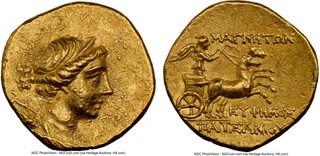| Heritage World Coin Auctions > CSNS Signature Sale 3115 | Auction date: 8 May 2024 |
| Lot number: 32122 Price realized: This lot is for sale in an upcoming auction - Bid on this lot  | Show similar lots on CoinArchives Find similar lots in upcoming auctions on |
| Lot description: Ancients IONIA. Magnesia ad Maeandrum. Ca. mid-2nd century BC. AV stater (18mm, 8.42 gm, 12h). NGC Choice AU 5/5 - 4/5. Ca. 155-145 BC, Euphemus and Pausanius, magistrates. Draped bust of Artemis right, wearing stephane, hair gathered into knot at back of head, quiver and bow over shoulder / ΜΑΓΝΗΤΩΝ, Nike driving biga galloping right, kentron in right hand, reins in left; ΕΥΦΗΜΟΣ below horses, ΠΑΥΣΑΝΙΟΥ below ground line. BMC Ionia -. SNG Von Aulock -. SNG Copenhagen -. Delightful example with microgranular fields. Magnesia ad Maeandrum was founded on the banks of the Lecathus, a tributary of the Maeander river, in south-western Ionia circa the mid-700s BC by a tribe from Thessaly known as the Magnetes, plus colonists from Crete. In the mid-2nd century BC, Magnesia was among the cities that enjoyed a Renaissance of classical Greek coinage, issuing large and beautiful stephanophoric ("wreath bearing") silver tetradrachms bearing a lovely head of the city's patron goddess, Artemis, with a reverse depicting her brother Apollo standing atop a meander pattern. These coins carried the names of a series of magistrates (or, as suggested by Nicholas F. Jones, wealthy civic patrons who financed the coinage), including probably the same Euphemos and Pausanius named on this gold stater, allowing us to date this remarkable piece to the same era as the stephanophoric tetradrachms, circa 155-145 BC. While Artemis graces the obverse, the reverse depiction of Nike driving a biga is otherwise unknown on any coinage of Magnesia and suggests that the issuance of our stater was in honor of a military victory of some kind, or perhaps the anniversary of a great victory. Since Magnesia was not itself a military powerhouse, the occasion must remain an open question, although the 40th anniversary of the Battle of Magnesia, which fell in December 150 BC, is a possibility. Although the battle between the Roman Republic and the Seleucid Kingdom occurred near a different Magnesia (ad Sipylum in Lydia), it effectively freed western Asia Minor from Seleucid control and gave the cities therein a large measure of autonomy within the loosely controlled Pergamene Kingdom. https://coins.ha.com/itm/ancients/greek/ancients-ionia-magnesia-ad-maeandrum-ca-mid-2nd-century-bc-av-stater-18mm-842-gm-12h-ngc-choice-au-5-5-4-/a/3115-32122.s?type=DA-DMC-CoinArchives-WorldCoins-3115-05082024 HID02906262019 © 2024 Heritage Auctions | All Rights Reserved |  |



